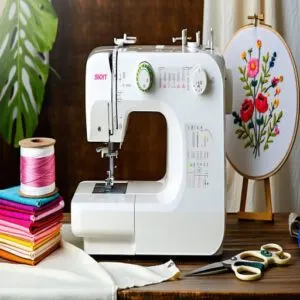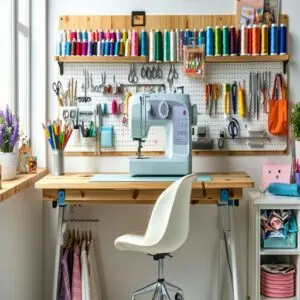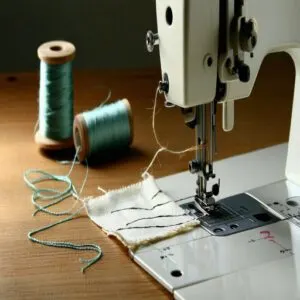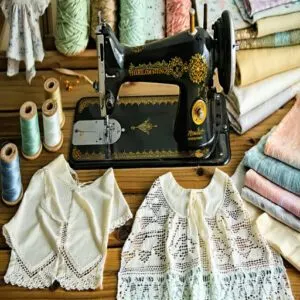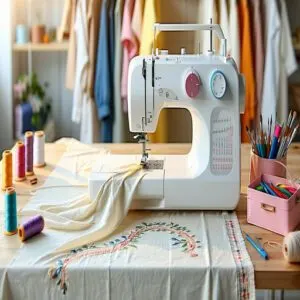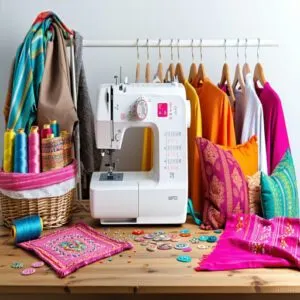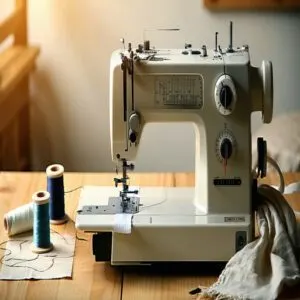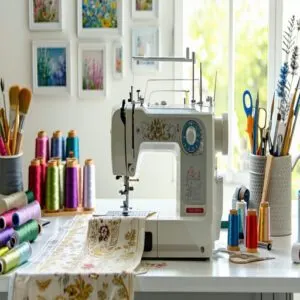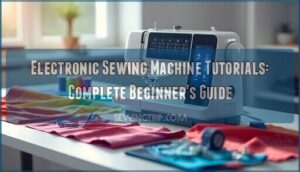This site is supported by our readers. We may earn a commission, at no cost to you, if you purchase through links.
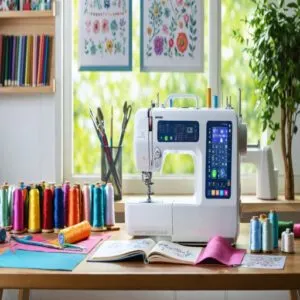
Start by choosing the right machine—computerized models offer fancy stitches, while mechanical ones give you hands-on control.
Stock up on essentials like stabilizers to prevent fabric warping, sharp needles for crisp designs, and high-quality thread for smooth results.
Always test on scrap fabric first; trust me, it’s better to mess up there than on your favorite project.
Play with stitch settings like tension, width, and length to customize your designs.
And remember, the right stitch on the wrong fabric? That’s a recipe for regret.
Table Of Contents
Key Takeaways
- Test your decorative stitches on scrap fabric first to avoid ruining your project and fine-tune settings like tension, width, and length.
- Use stabilizers, sharp needles, and high-quality thread to prevent fabric warping, ensure clean designs, and achieve smooth results.
- Match your stitch patterns to the fabric type and thread color for the best results, and always adjust settings to suit the material.
- Regularly clean your sewing machine and choose the right needle and thread to avoid issues like puckering, thread breakage, or uneven stitches.
Mastering Decorative Stitches
Learning decorative stitches on your sewing machine isn’t just about pressing a button; it’s about turning plain fabric into something extraordinary.
With the right tools, a bit of practice, and a dash of patience, you’ll be amazed by what you can create!
Choosing The Right Sewing Machine
Finding the right sewing machine isn’t rocket science, but it’s worth considering a few essentials.
- Machine Comparison: Computerized models offer advanced sewing machine stitches, while mechanical ones provide hands-on control.
- Weight Balance & Motor Power: A heavier machine handles thick fabrics better and boosts stability.
- Sewing Speed & Thread Capacity: Faster machines reduce project time, but thread limits matter too!
When choosing a sewing machine, considering the best sewing machines can help you make an informed decision.
Essential Supplies for Decorative Stitching
Your sewing machine stitches shine brightest with the right supplies.
Stock up on stabilizers to prevent fabric warping, sharp needles (or wing needles for heirloom stitching), and high-quality thread for smooth embroidery stitches.
Scrap fabric is perfect for testing designs, while sewing notions like marking pens guarantee precision.
Proper needle care keeps decorative sewing stitches flawless every time.
Having the right sewing kit essentials is vital for achieving professional-looking results in various sewing projects.
Practicing With Scrap Fabric
Think of scrap fabric as your creative playground. It’s the perfect place to test decorative sewing stitches without the stress of ruining your project.
Here’s how to practice smart:
- Avoid frustration by testing stitch tension first.
- Draw guides on the fabric to keep your stitching tidy.
- Try different threads to see their effect.
- Keep scraps organized for future experiments!
Decorative Stitch Techniques
You’ve got the power to transform plain fabric into something stunning with just a few stitch settings and a bit of creativity.
Let’s tackle how to select the right patterns, troubleshoot hiccups, and tweak stitch designs so your projects turn out flawless every time.
Selecting Stitch Patterns and Settings
Picking a stitch pattern can feel like choosing ice cream—so many delicious options.
Match your stitch patterns to fabric choice and thread color for eye-catching results.
Play with stitch settings like tension control and stitch density on your sewing machine.
Machine embroidery or fancy designs? Practice first!
The wrong stitch on the wrong fabric? That’s a recipe for regret, especially with machine embroidery.
Troubleshooting Common Issues
Things don’t always stitch smoothly, right?
If you’re battling thread breakage, stitch skipping, or tension issues, start with sewing machine troubleshooting basics: rethread the machine, check your needle, and adjust stitch tension.
For a detailed guide to common problems, consult this sewing machine troubleshooting guide.
Fabric warping or puckering? A stabilizer or tweaking tension might help.
Regular sewing machine maintenance keeps errors at bay—think of it as a tune-up for creativity!
Adjusting Stitch Length and Width
Tweaking stitch length and width is like finding the sweet spot in your morning coffee—it has to be just right.
Long stitches glide over thick fabrics, while shorter ones bring precision to delicate ones.
Remember, fabric density calls the shots, so test before stitching.
Combine stitch calibration with thread tension, sewing speed, and needle size for flawless decorative stitches every time!
Types of Decorative Stitches
Your sewing machine is bursting with decorative stitch options, each designed to add charm and personality to your projects.
From timeless heirloom stitching to bold satin designs, understanding these stitch types opens up endless possibilities for creative expression.
Heirloom Stitching and Wing Needles
Ready to add some vintage charm to your projects? Heirloom stitching with a wing needle creates those delicate, lacy holes perfect for napkins or little dresses.
Start with a stitch guide and practice on scraps to nail your technique.
- Fabric selection matters: Linen or osnaburg work beautifully.
- Needle care counts: Use a sharp wing needle.
- Stitch variations shine: Experiment with double hemstitch lines!
Satin Stitches and Embroidery Needles
Satin stitches are the showstoppers of decorative stitches, offering smooth, dense lines perfect for bold designs.
To nail these, focus on thread tension and stitch density—too tight, and it puckers; too loose, and it’s sloppy.
For a thorough guide, explore various decorative embroidery stitches for clothing.
Pair your sewing machine embroidery with embroidery needles for precision, and remember that fabric choice matters too; lighter fabrics shine with satin stitches, but always test first!
Decorative Stitches for Garments and Accessories
Decorative stitches transform everyday pieces into stunning works of textile artistry.
Add fabric embellishments to collars, hems, or sleeves for unique garment details.
Play with stitch placement on accessories like bags or scarves to elevate your designs.
Your sewing machine stitches can turn simple projects into bold statements.
With a little practice, decorative machine stitches reveal endless possibilities for garment embellishment and accessory designs.
Sewing Machine Settings
Getting the right settings on your sewing machine is like tuning a guitar—you’ll know when it’s perfect.
From adjusting stitch width to mastering tension, these small tweaks can make your decorative stitches look flawless and professional.
Customizing Stitch Width and Length
Tweaking stitch width and length transforms decorative stitches from basic to breathtaking.
For precision control, follow these tips:
- Experiment with Stitch Density: Adjust lengths for tight or loose patterns that suit fabric compatibility.
- Test on Scrap Fabric: Stitch tutorials often skip this, but it’s key to avoiding surprises.
- Balance Sewing Speed: Slow down for intricate designs to nail perfect sewing machine stitches.
The provided instructions highlight the importance of careful adjustment and testing to achieve the desired outcome in sewing, emphasizing the need for precision control and the avoidance of mistakes through thorough preparation.
Tension Control for Perfect Stitches
When your decorative stitches look wonky, it’s likely a tension control issue.
Adjusting stitch tension balances thread tension and prevents loops or puckering.
For a thorough guide to troubleshooting tension problems, explore this helpful resource on sewing machine tension fixing.
Test on scrap fabric to fine-tune stitch regulation for different materials.
Clean your machine often—dust messes with stitch balance.
| Issue | Cause | Fix | Tools Needed | Tip |
|---|---|---|---|---|
| Loose stitches | Low top tension | Increase top tension dial | Screwdriver, scrap | Test on similar fabric first |
| Tight stitches | High top tension | Decrease tension setting | Scrap fabric | Adjust gradually |
| Loops underneath | Bobbin tension off | Adjust bobbin screw | Small screwdriver | Tiny turns work best |
| Fabric puckering | Wrong tension or needle | Adjust tension, use stabilizer | Stabilizer, sharp needle | Use lightweight stabilizer |
| Uneven stitches | Dust buildup | Clean machine | Soft brush | Regular cleaning prevents it |
Choosing The Right Needle for Decorative Stitches
The right needle is your secret weapon for flawless decorative stitches.
Match needle size to fabric types—delicate fabrics love smaller needles, while heavier ones need sturdier sizes.
Needle materials matter too; metallic threads pair best with metallic needles for stitch precision.
Always check thread compatibility to avoid breakage.
A good stitch guide guarantees your sewing machine needles deliver perfection every time.
For a wide selection, explore these sewing machine needle products.
Advanced Decorative Stitching
You’ve mastered the basics, so now it’s time to take your decorative stitching skills to the next level with bold threads, precision tools, and creative flair.
Don’t be afraid to experiment—metallic threads and intricate designs can turn even simple projects into showstoppers!
Using Metallic Thread and Topstitch Needles
Metallic thread can be tricky, but it’s worth the shimmer! Pair it with a topstitch needle for smooth sewing and fewer snags.
Here’s how to avoid thread tension issues and needle breakage:
- Use a thread stand for even feeding.
- Loosen tension slightly.
- Slow your stitching speed.
- Choose high-quality metallic thread—it’s a game-changer!
Creating Intricate Patterns and Designs
When you mix stitch patterns with clever fabric manipulation, your sewing machine stitches can create jaw-dropping embroidery designs.
Play with stitch variations and pattern mixing to add texture and unique design elements.
Understanding advanced sewing techniques is essential for mastering decorative stitches and creating intricate patterns.
Use this quick guide for inspiration:
| Technique | Effect | Best Fabric Types | Pro Tip |
|---|---|---|---|
| Satin Stitches | Smooth, shiny finish | Silks, satins | Use stabilizer for precision |
| Feather Stitches | Delicate, airy patterns | Lightweight fabrics | Adjust tension carefully |
| Cross Stitches | Bold, geometric designs | Medium-weight fabrics | Test on scraps first |
| Chain Stitches | Textured, linked effect | Denims, linens | Slow speed for control |
Incorporating Decorative Stitches Into Sewing Projects
How do you take decorative stitches from practice to perfection? It’s all about thoughtful project planning and creative flair.
Here’s how:
- Choose fabrics that highlight your stitch patterns.
- Sketch stitch placement before sewing.
- Match thread choices to your design.
- Adjust sewing speed for control.
- Incorporate decorative machine stitches into hems, collars, or accessories for a polished touch.
Frequently Asked Questions (FAQs)
How to use decorative stitches on your sewing machine?
Start by picking a stitch pattern, adjust your machine’s settings, and test on scrap fabric with stabilizer.
Practice controlling speed and tension.
Once confident, stitch your design onto the final project with precision and flair!
What is the best thread for decorative stitches?
Picture silky threads gliding effortlessly through fabric.
Use high-quality polyester or rayon thread for decorative stitches—they’re strong, smooth, and shiny.
Avoid cheap thread; it frays faster than your patience during a tricky project!
What type of sewing machine is used for fancy stitches?
You’ll need a sewing machine with built-in decorative stitch options.
Look for models offering adjustable stitch width, length, and tension.
Bonus points if it has a touchscreen or memory settings to save custom designs!
What is the main purpose of decorative stitches in sewing?
They let you turn plain fabric into something special, adding texture, personality, or even a vintage vibe.
It’s like giving your project a little flair that makes people say, “Wow, you made that?”
How do I clean my sewing machine?
Did you know 70% of sewing machine issues stem from poor maintenance.
This means you should clean yours by removing lint with a brush, wiping surfaces, and oiling as needed.
Treat it like a car—it runs better with care!
What fabrics work poorly with decorative stitches?
Slippery fabrics like silk or satin can bunch up, while stretchy knits may warp under decorative stitches.
Thick materials like denim might break needles or jam your machine.
Always test on scraps first—it’s a lifesaver!
Can decorative stitches be done by hand?
You can absolutely tackle decorative stitches by hand.
It takes patience, practice, and a steady hand, but techniques like embroidery, chain stitching, and satin stitching can achieve stunning results—no machine required.
How do I store stabilizers properly?
Keep stabilizers in a cool, dry spot, away from sunlight or humidity.
Use airtight containers or resealable bags to prevent moisture damage.
Treat them like pantry staples—nobody wants soggy cereal or wrinkly stabilizer!
What thread types are best avoided?
Threads that fray like a bad breakup—cheap cotton, low-quality polyester, or old spools—are best avoided.
They tangle, snap, and ruin your flow.
Stick to strong, smooth threads for frustration-free stitching magic.
Conclusion
Imagine turning a plain pillowcase into a stunning centerpiece with just a few decorative stitches—your sewing machine can do that and so much more.
By mastering decorative stitches on your sewing machine, you’ll discover endless creative possibilities, whether it’s adding flair to garments, personalizing gifts, or elevating home décor.
With the right tools, practice, and a bit of experimentation, you’ll transform your projects from ordinary to extraordinary.
So, plunge in and let your creativity shine!
- https://www.dutchlabelshop.com/en_us/blog/mastering-advanced-sewing-techniques/
- https://sewingtrip.com/how-to-use-a-sewing-machine/
- https://sewfrenchcrossstitch.com/how-to-use-a-janome-sewing-machine/
- https://www.centreofexcellence.com/types-of-hand-sewing-stitch/
- https://www.linda-matthews.com/ten-ways-to-use-the-decorative-stitches-on-your-sewing-machine/

